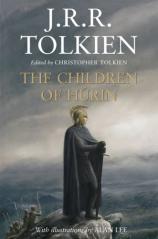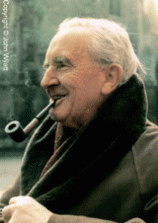The Children of Hurin
Review
The Children of Hurin
J.R.R. Tolkien exploded to new heights of popularity in the mainstream with the release of the film translations of his famed THE LORD OF THE RINGS. Sales of the series soared, and interest in all things Tolkien knew no bounds. Now, a few years removed from that mass media frenzy, Christopher Tolkien has decided it’s time to return the focus of the Tolkien legacy where it belongs: on the printed word.
Christopher opens THE CHILDREN OF HURIN with his own commentary; he says he did as little as possible to insert his own ideas or inferences into the piece, pulled together from extensive but scattered notes left by his late father. The tale of Túrin has been mentioned in minor variations in more than one previous work, but this marks the first time that the full story has been told and likely will be the last full-length journey to Middle Earth.
THE CHILDREN OF HURIN does not read as straightforward as THE LORD OF THE RINGS and by no means should it. This tale, which is older than the Middle Earth of the War of the Ring and older than the power of the dark lord Sauron, tells of lands long since drowned by the rising of the sea. It is mythological, mythic in size and scope, and thus told with reverence, as all stories of long-ago heroes are told.
However, this does not keep the story from accessibility. Previously, the posthumous works such as UNFINISHED TALES or THE SILMARILLION were criticized heavily for the dry and near-religious presentation, so drastically different from THE HOBBIT and THE LORD OF THE RINGS as to be unreadable by the masses. Initially, names will come fast and furious, but once you become accustomed to the various places and characters, the reading will progress quite smoothly. Included in the book is a map that comes in handy and an index of names to help you keep things straight.
This is a tale worthy of the telling, and one that was intensely important to Tolkien. Beren and Lúthien were oft-spoken of in THE LORD OF THE RINGS, and Túrin was mentioned only in passing, but his legend and curse were vital to Tolkien's world.
THE CHILDREN OF HURIN is a tragedy and a tale of great sorrow, and its sadness begins early on for the child Túrin, whose younger sister, Urwen, dies from the illness that comes from the Evil Breath. Her death is a great blow to the melancholy Túrin. Their father, Húrin --- the lord of Dor-lómin --- marches with his men against the forces of Morgoth, the original Dark Lord. His men are slain by the orcs, and he is taken as a prisoner to the Dark King's sanctuary. There, Morgoth lays a curse upon his children, Túrin and Niënor, saying, "Upon all whom you love my thought shall weigh as a cloud of Doom, and it shall bring them into darkness and despair."
And so the doom of Man is set. Túrin is sent to Doriath, where he lives as the foster-child of the elven king Thingol (the father of Lúthien the Fair), long an ally of Húrin. There he grows to manhood but longs to take up arms against Morgoth. Fleeing Doriath, as he fears a punishment from the king (which never comes), Túrin takes up with brigands, eventually coming to see that more is needed of him --- and of the men who would follow him --- if he truly is to take after his father. Thus he begins to show his quality, and starts his rise in the legendarium of Middle Earth.
Part ancient epic (such as “The Kalevala”), part Oedipus, part Romeo and Juliet, and even part Beowulf, THE CHILDREN OF HURIN draws from a deeper well than most fantasy fiction and will move you on multiple levels. It is horrendously tragic and yet at the same time a wholly beautiful work that only deepens further the legend and legacy of Middle Earth.
Reviewed by Stephen Hubbard on April 17, 2007





